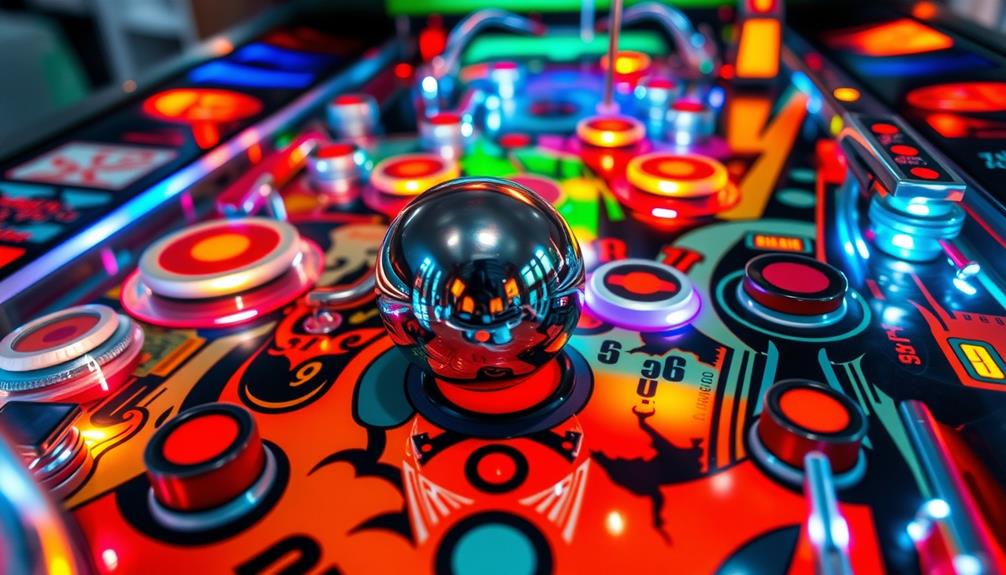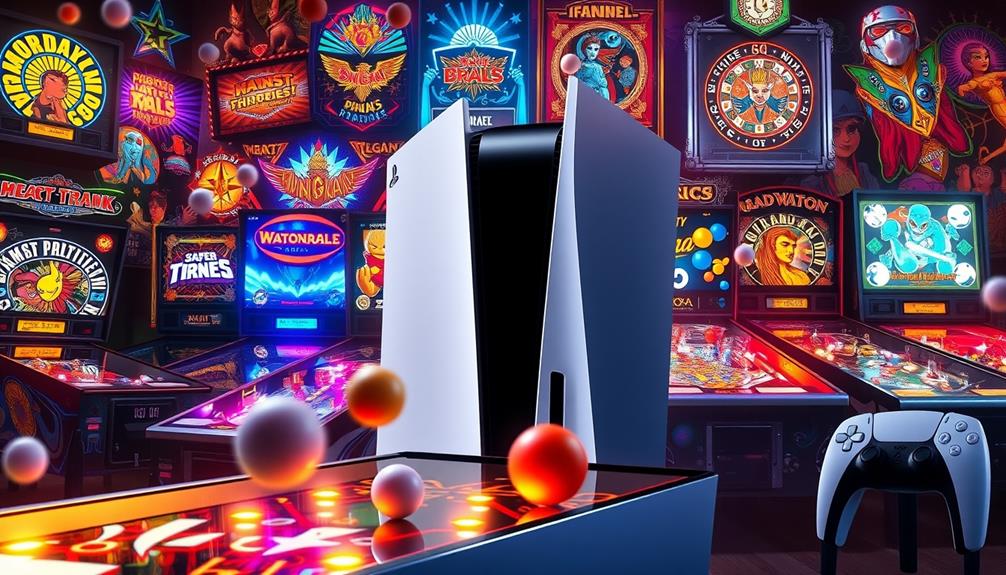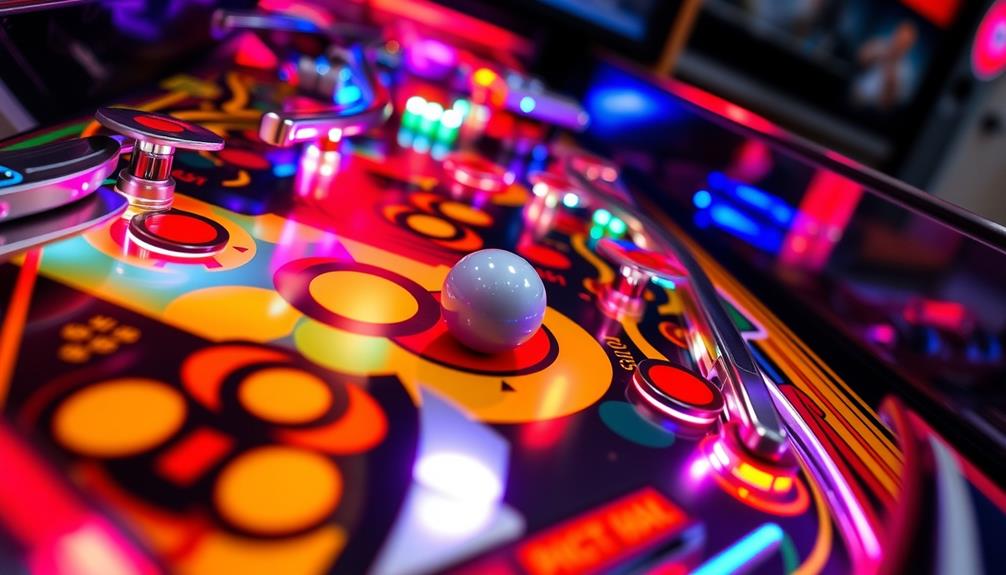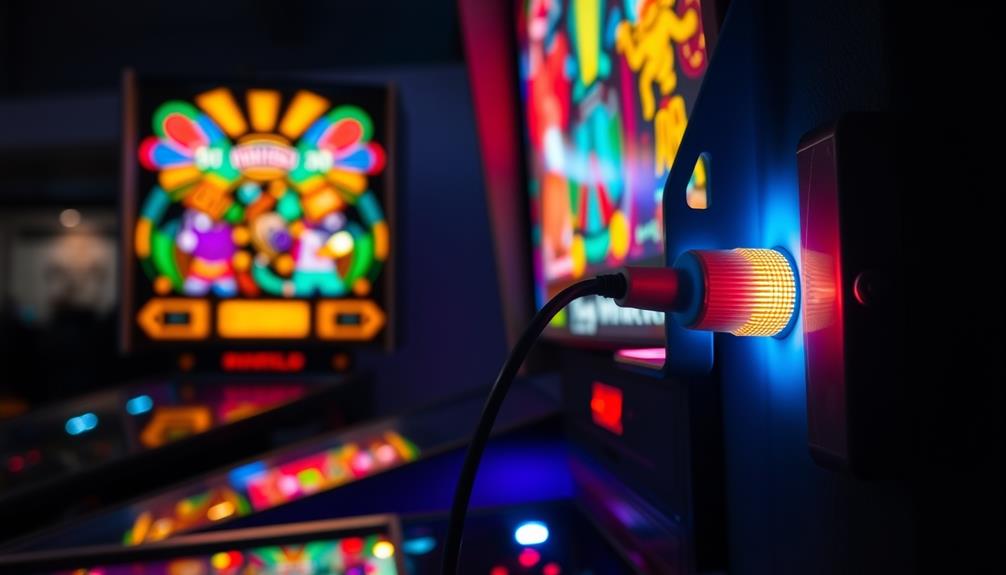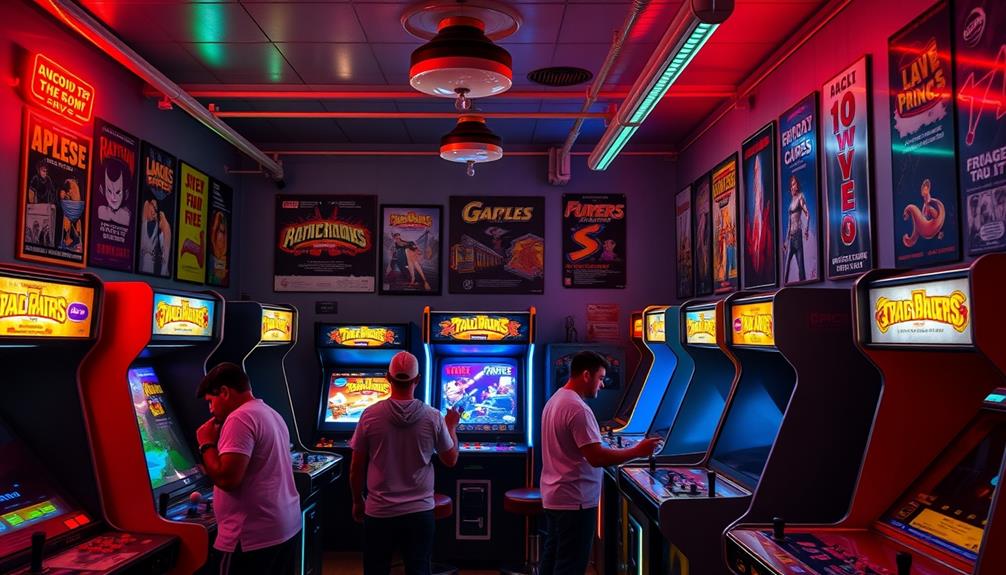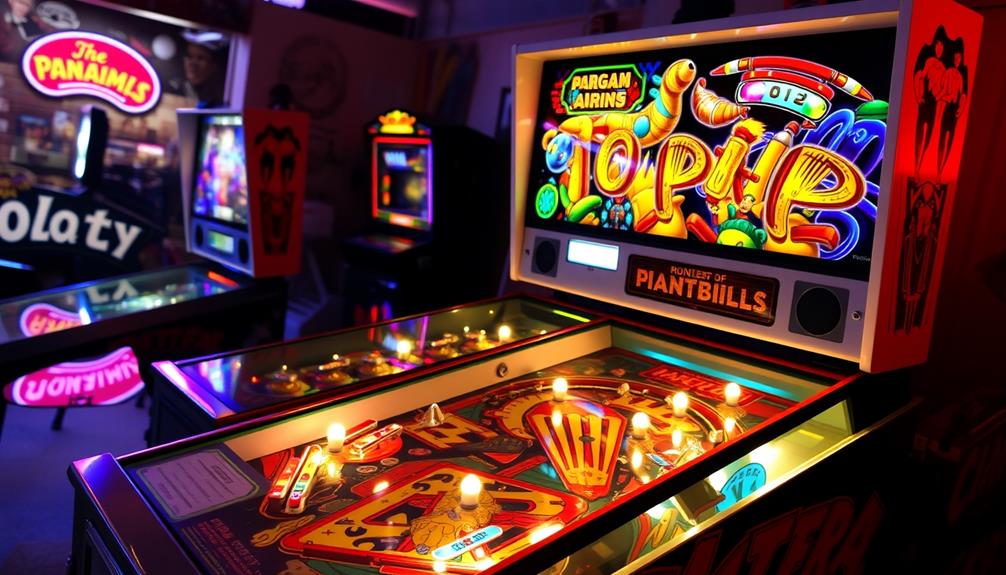Pinball is all about skill and strategy. You launch a steel ball onto a slanted playfield that is filled with targets and obstacles. Gravity influences the ball’s path as it rolls down, while bumpers and flippers help guide its direction. Points are earned by hitting specific targets and achieving objectives, often triggering exciting bonus rounds or multi-ball modes. A display at the back shows your score and other game statistics to keep you engaged. Pinball is a combination of mechanical components and real-time physics. Stay tuned for more insights on the evolution of pinball and its future trends.
Key Takeaways
- Pinball machines feature an inclined playfield where the ball interacts with targets, bumpers, and ramps to score points.
- Players launch the ball using a button, and flippers are controlled by side buttons to keep the ball in play.
- Scoring is achieved by hitting targets, completing objectives, and activating multi-ball modes for bonus points.
- The extensive wiring system connects electromechanical components, enabling real-time gameplay and dynamic interactions.
- Nostalgia and classic themes attract younger audiences, while manufacturers like Stern Pinball continue to innovate with new releases.
Pinball Machine Components
Pinball machines have several essential components that come together to create an exciting gameplay experience. At the heart of the machine is the playfield, typically made of wood and inclined at a 6-7 degree angle. This is where you'll find various targets and obstacles, including bumpers and ramps, that interact with the ball during play.
The charm and allure of pinball machines can be compared to the Star Appeal: Astrology and Attractiveness of the players who enjoy them, as both elements contribute to the overall experience.
Flippers are located at the bottom of the playfield, controlled by buttons on each side. These critical components prevent the ball from draining and help propel it upward, enhancing your chances of scoring.
The backbox, positioned above the playfield, houses the main electronics, including the dot-matrix display that shows your score and gameplay information.
Behind the scenes, extensive wiring—often exceeding half a mile—connects all the electromechanical components. This intricate network guarantees that everything functions smoothly, allowing for a seamless interaction between the ball, flippers, and targets.
Each component plays an essential role in creating the thrilling experience you enjoy when you step up to a pinball machine.
Gameplay Mechanics and Scoring
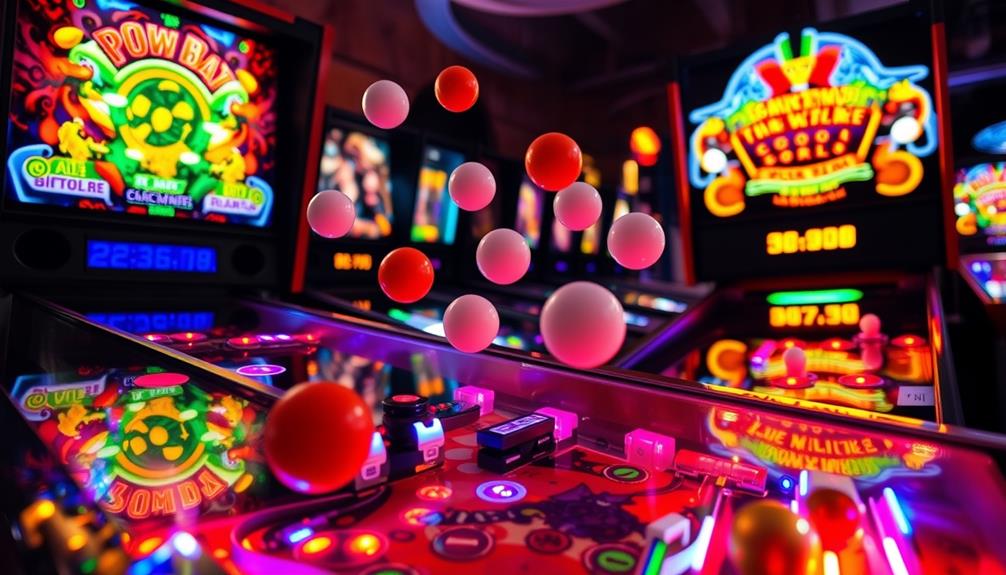
In a pinball game, scoring hinges on hitting targets, completing objectives, and activating bonuses that light up on the dot matrix display. Players use flippers to launch the ball, aiming for specific targets that can lead to increased scores. Achieving combination shots is essential, as these can trigger jackpots and offer even more scoring opportunities, with the sequences differing by machine.
Additionally, the design of each machine often incorporates unique features that can affect gameplay strategy, similar to how building codes and zoning laws vary for tiny houses.
To enhance gameplay, experienced players often focus on completing certain objectives, like activating multi-ball modes, which can drastically boost their scores. The replay value is a significant aspect of modern pinball machines, rewarding players with free games once they reach a score threshold, typically within the top 10%.
At the end of the game, you can also participate in the match feature, where a random two-digit number is displayed. If it matches the last two digits of your score, you earn additional free plays, adding an exciting twist to the gameplay.
Historical Development of Pinball

Understanding how gameplay mechanics and scoring evolved can deepen your appreciation of pinball's rich history. The journey of pinball began in the 1500s with outdoor games like bocce and ground billiards, eventually leading to tabletop versions that set the stage for modern machines. Gottlieb's Baffle Ball, released in the 1930s, is often hailed as the first successful coin-operated pinball machine, transforming entertainment for just a penny.
With the introduction of flippers in the 1940s, particularly in Gottlieb's Humpty Dumpty, gameplay dynamics shifted considerably. This marked a crucial technological advancement that allowed players to actively control the ball. The late 1970s introduced the microprocessor, with machines like Bally's Flicker replacing traditional electromechanical components, enabling complex gameplay and innovative scoring systems.
Here's a quick overview of pinball's historical milestones:
| Year | Milestone |
|---|---|
| 1930s | Baffle Ball released by Gottlieb |
| 1940s | Introduction of flippers |
| 1970s | Microprocessor revolution |
| 1990s | Decline of major manufacturers |
| 2010s | Rise of independent companies |
These developments showcase how far pinball has come, constantly evolving to captivate players.
Industry Trends and Future Developments
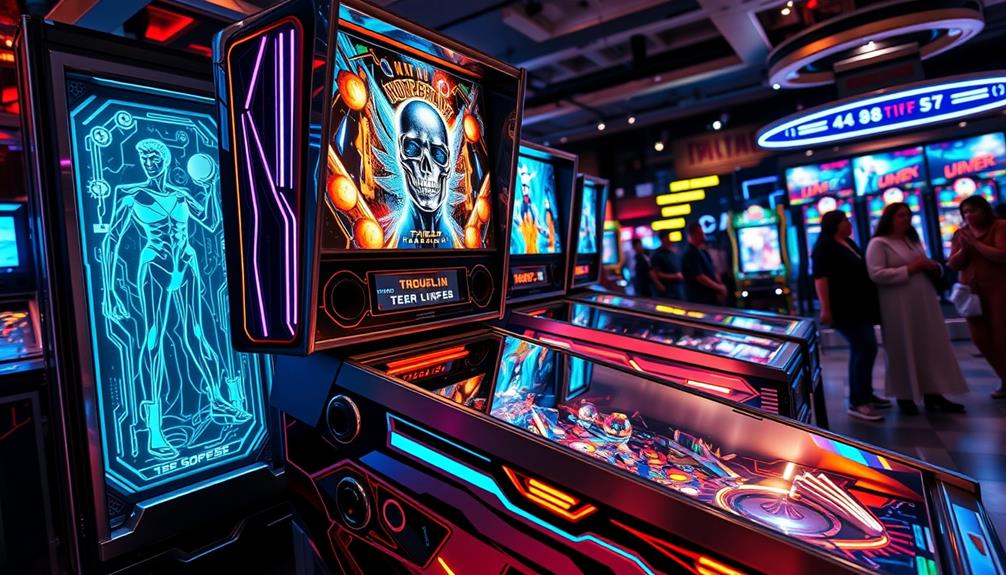
As the pinball industry navigates a landscape shaped by digital gaming and changing player preferences, it continues to find ways to engage a dedicated audience. While Stern Pinball remains the major manufacturer in a market that once boasted five giants, nostalgia plays an essential role in maintaining interest, particularly among young players aged 18 to 35. This demographic is drawn to retro aesthetics and classic gameplay experiences, keeping the spirit of pinball alive.
Additionally, the industry has seen a resurgence of interest in classic music themes, similar to the way Blue Skies and Lemonade evokes feelings of joy and nostalgia, which resonates with players looking for familiar experiences.
Stern aims to release 3-4 new machines annually, reflecting its commitment to attracting younger audiences. Meanwhile, independent manufacturers like Jersey Jack Pinball introduce innovative designs, featuring large color displays that enhance gameplay. These advancements are vital as the industry adapts to modern tastes and preferences.
Looking ahead, the pinball industry may embrace technology advancements, potentially incorporating virtual reality into the gameplay experience. This move could reshape player engagement, creating immersive environments that captivate new players.
As the industry evolves, it endeavors to balance nostalgia with cutting-edge technology, ensuring that pinball remains relevant in a competitive gaming landscape.
Ball Dynamics and Machine Interaction
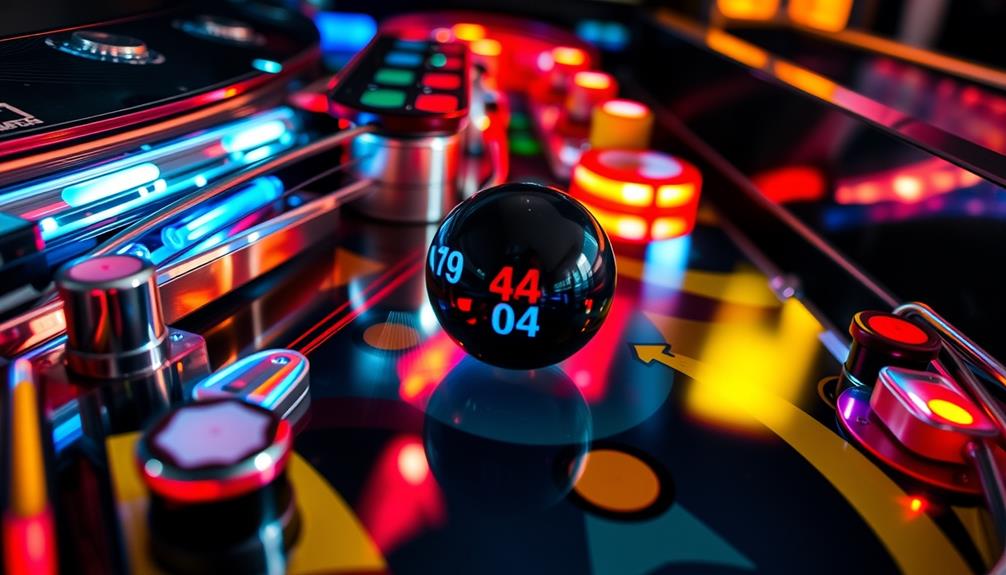
Pinball machines come alive through the intricate dance of ball dynamics and machine interaction. When you press the launch button, you send a standard pinball, weighing 2.8 ounces, soaring into the inclined playfield. This 6-7 degree angle harnesses gravity to influence the ball's trajectory, while bumpers and flippers redirect its path, creating an engaging experience.
Here's how key components interact:
| Component | Function |
|---|---|
| Flippers | Propel and redirect the ball |
| Bumpers | Bounce the ball unpredictably |
| Launch Button | Initiates ball movement |
| Wiring System | Enables real-time gameplay |
As the ball navigates the playfield, it interacts with various obstacles, influenced by the machine's design. Each collision alters its speed and direction, allowing for dynamic gameplay. The complex wiring system connects over half a mile of wires to the main controller, ensuring every action you take is mirrored instantly on the screen. This seamless interaction between ball dynamics and machine components keeps you on your toes, enhancing the thrill of the game.
Frequently Asked Questions
How Do You Actually Play Pinball?
To play pinball, you insert coins, press Start, and launch the ball. Use flipper buttons to keep it in play, aiming for targets to score points while avoiding tilting the machine. Enjoy the competitive fun!
How Does a Pinball Work?
Imagine a steel ball dancing on a tilted playground, where you control its fate. You launch it, dodge drains with flippers, and aim for targets, all while chasing that elusive high score. It's exhilarating!
How Does Pinball Scoring Work?
In pinball scoring, you rack up points by hitting targets and completing sequences. You can earn free games by reaching score thresholds and matching your score's last two digits, so aim for those jackpots!
What Are the Basics of Pinball?
In pinball, you control flippers to keep the ball in play while aiming for targets and bumpers. You start by inserting coins, launching the ball, and competing for high scores, either solo or with friends. There are often multiple levels to progress through and different missions to complete, adding an element of strategy to the game. As you play, you’ll learn how to use the flippers to keep the ball in play and how to aim for specific targets to earn more points. Understanding how pinball scoring works is crucial to achieving a high score and mastering the game. Additionally, some machines offer bonus rounds or special features that can help you rack up even more points.
Conclusion
In summary, understanding how pinball works reveals the intricate dance between player skill and machine design. Each component plays an essential role in creating an engaging experience, while gameplay mechanics keep you on your toes. As the industry evolves, remember that "what goes up must come down"—just like the ball you launch. Embracing both the nostalgia and innovation in pinball guarantees this timeless game continues to captivate players for generations to come.
